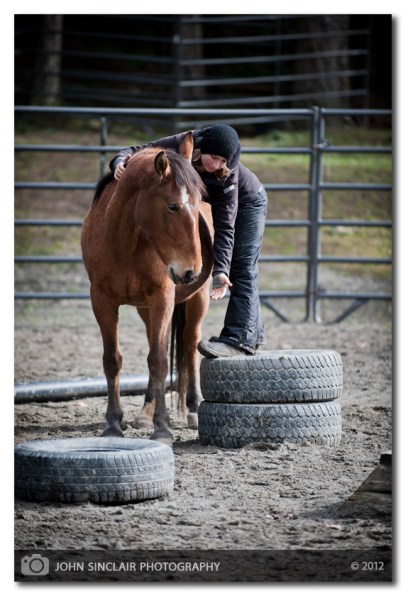One Mustang directly off the range
One trainer
No tools
Just body language
The Goal:
To discover how far Equestrian Art can be developed solely using body language.
The Grass is Always Greener…
Spring is springing here in the Northwest and a brilliant emerald carpet is emerging everywhere, green with the lush irresistible scent of spring. Though Myrnah is out on the pasture with her herd every day, there is that irrefutable idea: The grass is always greener on the other side of the fence.
The paddocks we are holding aside for Myrnah to foal in and use as her nursery are the most beautiful places to graze in the valley. At this point they are also the driest and easiest places for Myrnah and me to practice our skills each day. I think this works both for and against us. On the one hand, Myrnah is often frustrated when I insist on practicing our movements together instead of allowing her to eat nonstop as would be her preference. On the other hand, that green, green grass becomes a perfect reward for extra effort and remarkable moments of development.
In the middle of this paddock we have been practicing in, there is a small jump- a simple cavaletti that can be rolled so it is a pole on the ground, or a pole raised a foot or so off the ground. Here is a sequence of pictures taken the first time Myrnah followed me over that obstacle.
Upon reaching the other side she touched my hand with her nose, and I dropped down to let her graze for awhile; little did I know how incredibly powerful that reward system would turn out to be. In no time at all going over that cavaletti was all she wanted to do. So I added challenge to the game. As soon as she started to step over the pole I would run away, so she had to run after me to touch my hand before she could have her coveted bit of grass. The runs became longer and faster, and for the first time ever I had Myrnah cantering WITH me.
Setting up a pattern Myrnah understood, with a goal in mind that she wanted to get to, all of a sudden made the practice of speed a viable game for us. I had been trying to figure out how to develop our canter together; I just had no idea she would want to start jumping before she was inspired to canter with me. As I made the game faster I thought she would lose interest, but surprisingly I was wrong. That jump was still her favorite game. Over and over again she wanted to play. I even challenged her by seeing how long I could steer her away from the cavaletti before I finally allowed Myrnah her jump, canter away, and grazing moment. She certainly was frustrated by my game of keep away, but a few minutes of frustration seemed to feed her desire. Not only is the grass greener on the other side of the fence, it is also greener on the other side of a jump!
Now I am sure, being pregnant, and less than graceful right now gives Myrnah good reason to prefer grazing and grooming and quiet still games with me, over the speed and riding games I continue to want to play. So if I can add a little incentive of coveted grass beyond her everyday travels of the pasture, I think that is a good thing.
Riding is progressing beautifully. Yes, we still have our willful moments where neither of us wants to give over leadership to the other. Those moments are shorter and shorter lived though and our patterns of travel continue to develop. Walking, stopping, and backing up are all pretty easy for us now, though our walks are broken up by a multitude of volunteered stops where Myrnah asks if she can please graze now? Bending to a stop, my fingertips on the side of her neck asking her to bring her nose around and touch my foot is a solid skill, since I usually ask for that just before I let her graze. Turning and changing direction at walk are still a major discussion point; Myrnah is not sure why I get to make so many decisions when she is the one carrying me.
The most fun though is the trot. Today, for the first time, Myrnah started offering the trot and maintaining it for longer and longer stretches. Her trot has a sort of passage feel to it- light and elevated- I think because with every step she is wondering if she has gone far enough to have earned a grazing break. She doesn’t really want to go anywhere; she is just doing her best to please me so we can get back to the eating part of the exercise.
When I am riding I make sure the jump is at its lowest setting with the pole right on the ground. Small and simple as it is, I am still thrilled when Myrnah decides carrying me over an obstacle is fun, and trotting away from the jump becomes patterned and simple for us. I have a feeling we are still a long way from riding a canter together, but who knows… progress is never linear. Sometimes it moves in leaps and bounds when you least expect it to.
For now I will continue to revel in the beautiful moments, reward Myrnah often with the time grazing she longs for, and develop our skills one small step at a time.
The grass is always greener when you have to work a little to earn it. May our challenges always be in balance with our rewards.
Elsa Sinclair
































